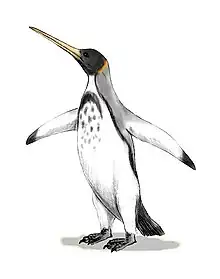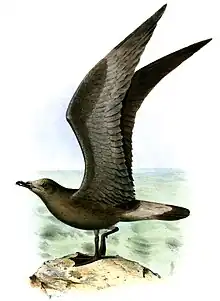Kaiika
Kaiika (Māori for "eater of fish") is an extinct genus of basal penguin from Early Eocene (Waipawan-Mangaorapan subage) deposits of South Canterbury, New Zealand. It is known only from a single humerus. It was found in 1998 by Dr Phillip Maxwell, a paleontologist and stratigrapher, from the Kauru Formation of the Canterbury Basin, near the Waihao River. It was first named by Ewan Fordyce and Daniel Thomas in 2011 and the type species is Kaiika maxwelli. Kaiika is one of the oldest penguins known.[1]
| Kaiika Temporal range: | |
|---|---|
| Scientific classification | |
| Domain: | Eukaryota |
| Kingdom: | Animalia |
| Phylum: | Chordata |
| Clade: | Dinosauria |
| Class: | Aves |
| Order: | Sphenisciformes |
| Genus: | †Kaiika Fordyce & Thomas, 2011 |
| Species | |
References
- R. Ewan Fordyce; Daniel Thomas (2011). "Kaiika maxwelli, a new Early Eocene archaic penguin (Sphenisciformes, Aves) from Waihao Valley, South Canterbury, New Zealand". New Zealand Journal of Geology and Geophysics. 54 (1): 43–51. doi:10.1080/00288306.2011.536521. S2CID 128676449.
This article is issued from Wikipedia. The text is licensed under Creative Commons - Attribution - Sharealike. Additional terms may apply for the media files.

